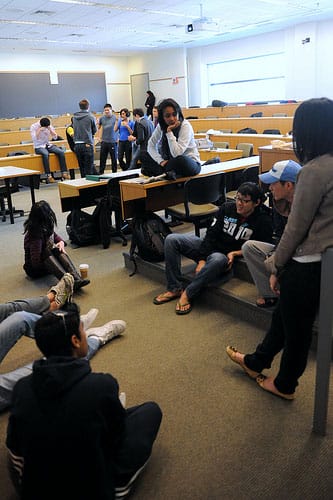Imagine entering Wharton as a first semester freshman. You instantly become immersed in an environment where knowledge and motivation is contagious.
Waiting for my omelet at the Plaza Café, I overheard graduate students discussing their work at Goldman Sachs, Bain, and tech startups. Attending the Ashton Kutcher talk on Penn’s campus [part of the Lauren and Bobby Turner Social Impact Executive Speaker Series], I listened to a renowned actor speak passionately about his activism and investments. Sitting in on a careers panel, I gained valuable insights into life as an investment banker or consultant.
These experiences highlight the opportunities that students have to learn by listening outside the classroom. The beauty of Wharton is that life is perfectly balanced between learning from others and learning by doing.
No class typifies this synergy better than Management 100. As first-semester freshmen, all Wharton students are enrolled in this course and assigned to a team of 10. Together, this team consults for a Philadelphia nonprofit to which it is assigned. Throughout the semester, students solve real problems faced by real organizations while applying business principles taught in course lectures. Speaking, writing and team-building exercises hone students’ skills as individuals and team players. The beauty of the class is its adaptive learning approach; in other words, mistakes are encouraged and remedies are rewarded. Wharton freshmen are a melting pot of cultures, personalities and strengths. When highly intelligent and diverse individuals work together, productivity grows exponentially.
During one of the first recitations of the year, our Management 100 teaching assistant handed each team member a card with instructions. He told us to remain silent, dropped rubber puzzle pieces on the classroom floor and yelled, “Begin!” In the absence of verbal instructions, our barely acquainted team had to use gestures to communicate. Within minutes, we realized that the goal of the activity was to form a colored pattern by fitting the puzzle pieces together in a very specific way. We succeeded in the allotted time, but those few minutes were the most challenging of my life. I am naturally verbal, and remaining silent was very agonizing. Only in retrospect do I realize how purposeful that assignment was. For a few minutes, my teammates and I put aside our differences and solved a problem completely objectively. Before I even knew my teammates’ names, we were united by a common challenge.
Just imagine how easily we all bonded after those few minutes.
Editor’s note: This post originally appeared on the Wharton Undergraduate Program’s Student Voices blog on Feb. 14, 2014.



























